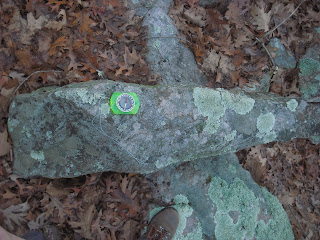Recently I revisited this site, which I showed 5/15/2013. This is a rocky east-facing slope, with what looks like a niche and a pointer.
The pointer is about three feet long and points at about 78 degrees.
Directly uphill is this large niche with slabs set on edge inside.
The lower edge of the top is sharp, as if stone was removed, and the top rests against a vertical slab.
The view inside.
Someone set these slabs on edge in here. If they had eroded off the larger slab, they would be lying flat.
The pointer points at a loose stone row that extends downhill. Further downhill are a few cairns, which I showed previously.
The view from the head of the stone row, showing the pointer pointing at the row with the niche directly behind.
The pointer doesn't seem to point to anything beyond the stone row. If there was something important, it would have been lost to development. These structures seem to be organized with niche, pointer, and stone row in a straight line.Whether it is a shrine or coincidence is a mystery.
Wednesday, December 18, 2013
Wednesday, December 11, 2013
Hundreds of Years of Use
Saturday afternoon I went for a walk at one of my favorite sites. A few years ago, I took this picture there:
Recently, I was reviewing these photos, and noticed that the stone in the bottom of the photo looked like it had a grinding slick on top. This site is a small hill overlooking a stream, and it was easy to find again.
Closer examination of the stone showed a grinding slick in a symmetrical stone with a flat top.
Here it is with the leaves removed.
If someone was using this grinding slick, she would face to the southwest.
Why face southwest? There are two possible reasons that are not mutually exclusive.
1. The god Kantantowit came from the southwest, bringing corn.
2. The winter sun would keep this stone warmer.
This propped boulder with a grinding slick (9/18/2013 ) also faces southwest, and is only 500 feet away.
These stones were shaped for a practical use, and saw hundreds of years of use. Their location on small hills near water suggests they were once part of campsites.
Recently, I was reviewing these photos, and noticed that the stone in the bottom of the photo looked like it had a grinding slick on top. This site is a small hill overlooking a stream, and it was easy to find again.
Closer examination of the stone showed a grinding slick in a symmetrical stone with a flat top.
Here it is with the leaves removed.
If someone was using this grinding slick, she would face to the southwest.
1. The god Kantantowit came from the southwest, bringing corn.
2. The winter sun would keep this stone warmer.
This propped boulder with a grinding slick (9/18/2013 ) also faces southwest, and is only 500 feet away.
These stones were shaped for a practical use, and saw hundreds of years of use. Their location on small hills near water suggests they were once part of campsites.
Wednesday, December 4, 2013
Subscribe to:
Posts (Atom)













